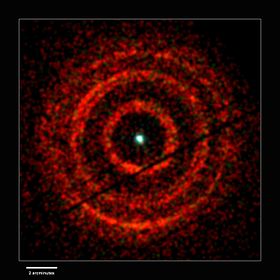| Observation data Epoch J2000.0 Equinox J2000.0 | |
|---|---|
| Constellation | Cygnus |
| Right ascension | 20h 24m 03.82s[1] |
| Declination | +33° 52′ 02.0″[1] |
| Apparent magnitude (V) | 11.2 - 18.8[2] |
| Characteristics | |
| Spectral type | K3 III[3] |
| U−B color index | +0.3[4] |
| B−V color index | +1.5[4] |
| Variable type | Nova[5] |
| Astrometry | |
| Proper motion (μ) | RA: −5.177[1] mas/yr Dec.: −7.778[1] mas/yr |
| Parallax (π) | 0.3024 ± 0.0783 mas[1] |
| Distance | 2,390[6] pc |
| Absolute magnitude (MV) | +3.4[7] |
| Details | |
| A (black hole) | |
| Mass | 9[6] M☉ |
| B | |
| Mass | 0.7[7] M☉ |
| Radius | 6.0[7] R☉ |
| Luminosity | 10.2[7] L☉ |
| Surface gravity (log g) | 3.50[8] cgs |
| Temperature | 4,800[8] K |
| Metallicity [Fe/H] | +0.23[8] dex |
| Rotational velocity (v sin i) | 36.4[8] km/s |
| C | |
| Mass | 1.2[9] M☉ |
| Radius | 1.85[9] R☉ |
| Surface gravity (log g) | 3.95[9] cgs |
| Temperature | 6123[9] K |
| Metallicity [Fe/H] | -0.09[9] dex |
| Age | 4 Gyr |
| Other designations | |
| Database references | |
| SIMBAD | data |
V404 Cygni is a microquasar and a binary system in the constellation of Cygnus. It contains a black hole with a mass of about 9 M☉ and an early K giant star companion with a mass slightly smaller than the Sun. The star and the black hole orbit each other every 6.47129 days at fairly close range. Due to their proximity and the intense gravity of the black hole, the companion star loses mass to an accretion disk around the black hole and ultimately to the black hole itself.[10]
The "V" in the name indicates that it is a variable star, which repeatedly gets brighter and fainter over time. It is also considered a nova, because at least three times in the 20th century it produced a bright outburst of energy. Finally, it is a soft X-ray transient because it periodically emits short bursts of X-rays.
The black hole companion has been proposed as a Q star candidate.[11]
- ^ a b c d e Brown, A. G. A.; et al. (Gaia collaboration) (2021). "Gaia Early Data Release 3: Summary of the contents and survey properties". Astronomy & Astrophysics. 649: A1. arXiv:2012.01533. Bibcode:2021A&A...649A...1G. doi:10.1051/0004-6361/202039657. S2CID 227254300. (Erratum: doi:10.1051/0004-6361/202039657e). Gaia EDR3 record for this source at VizieR.
- ^ Watson, C. L. (2006). "The International Variable Star Index (VSX)". The Society for Astronomical Sciences 25th Annual Symposium on Telescope Science. Held May 23–25. 25: 47. Bibcode:2006SASS...25...47W.
- ^ Khargharia, Juthika; Froning, Cynthia S.; Robinson, Edward L. (2010). "Near-infrared Spectroscopy of Low-mass X-ray Binaries: Accretion Disk Contamination and Compact Object Mass Determination in V404 Cyg and Cen X-4". The Astrophysical Journal. 716 (2): 1105. arXiv:1004.5358. Bibcode:2010ApJ...716.1105K. doi:10.1088/0004-637X/716/2/1105. S2CID 119116307.
- ^ a b Liu, Q. Z.; Van Paradijs, J.; Van Den Heuvel, E. P. J. (2007). "A catalogue of low-mass X-ray binaries in the Galaxy, LMC, and SMC (Fourth edition)". Astronomy and Astrophysics. 469 (2): 807. arXiv:0707.0544. Bibcode:2007A&A...469..807L. doi:10.1051/0004-6361:20077303. S2CID 14673570.
- ^ Samus, N. N.; Durlevich, O. V.; et al. (2009). "VizieR Online Data Catalog: General Catalogue of Variable Stars (Samus+ 2007-2013)". VizieR On-line Data Catalog: B/GCVS. Originally Published in: 2009yCat....102025S. 1. Bibcode:2009yCat....102025S.
- ^ a b Bernardini, F.; Russell, D. M.; Shaw, A. W.; Lewis, F.; Charles, P. A.; Koljonen, K. I. I.; Lasota, J. P.; Casares, J. (2016). "Events leading up to the 2015 June Outburst of V404 Cyg". The Astrophysical Journal Letters. 818 (1): L5. arXiv:1601.04550. Bibcode:2016ApJ...818L...5B. doi:10.3847/2041-8205/818/1/L5. S2CID 119251825.
- ^ a b c d Shahbaz, T.; Ringwald, F. A.; Bunn, J. C.; Naylor, T.; Charles, P. A.; Casares, J. (1994). "The mass of the black hole in V404 Cygni". Monthly Notices of the Royal Astronomical Society. 271: L10–L14. Bibcode:1994MNRAS.271L..10S. doi:10.1093/mnras/271.1.L10.
- ^ a b c d González Hernández, Jonay I.; Casares, Jorge; Rebolo, Rafael; Israelian, Garik; Filippenko, Alexei V.; Chornock, Ryan (2011). "Chemical Abundances of the Secondary Star in the Black Hole X-Ray Binary V404 Cygni". The Astrophysical Journal. 738 (1): 95. arXiv:1106.4278. Bibcode:2011ApJ...738...95G. doi:10.1088/0004-637X/738/1/95. S2CID 118443418.
- ^ a b c d e Burdge, Kevin B.; El-Badry, Kareem; Kara, Erin; Canizares, Claude; Chakrabarty, Deepto; Frebel, Anna; Millholland, Sarah C.; Rappaport, Saul; Simcoe, Rob; Vanderburg, Andrew (2024). "The black hole low mass X-ray binary V404 Cygni is part of a wide hierarchical triple, and formed without a kick". arXiv:2404.03719 [astro-ph.HE].
- ^ Kimura, Mariko; et al. (7 January 2016). "Repetitive patterns in rapid optical variations in the nearby black-hole binary V404 Cygni". Nature. 529 (7584): 54–70. arXiv:1607.06195. Bibcode:2016Natur.529...54K. doi:10.1038/nature16452. PMID 26738590. S2CID 4463697.
- ^ Brecher, K. (1993-05-01). "Gray Holes". American Astronomical Society Meeting Abstracts #182. 182: 55.07. Bibcode:1993AAS...182.5507B.
